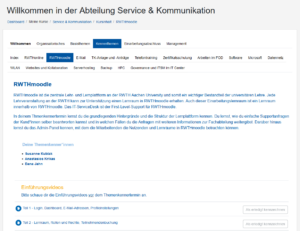The onboarding concept of the Service & Communication department
In order to successfully bring new employees on board, the IT Center’s Service & Communication department has introduced a mentoring concept. Read the interview to find out how the concept is structured and why it has proven successful.
Janin: How does onboarding work in the Service & Communication department?
Nadine: Onboarding in the Service & Communications department takes the form of mentoring. This means that each new employee (“mentee”) is individually supported and supervised by an experienced employee (“mentor”) during the first few weeks.
However, the entire process of familiarization with our work processes is very labor-intensive and time-consuming. A new employee has to learn the basics about the numerous services of the IT Center and how we support them, which admin interfaces we are allowed to use and much more. Teaching all of this would be too much for just one mentor.
Therefore, in order to spread this work over several shoulders, all employees in the department are assigned to one to three topics as so-called topic experts. A new employee is trained in the individual topics (e.g. RWTHonline, RWTHmoodle, e-mail) by these topic experts. This division of labor has several advantages: The mentor is relieved and the individual topics are taught by those people who are particularly knowledgeable – so not everyone has to know and be able to do everything. But the new employee also benefits, because she gets to know the different team members through the changing topic experts. This is particularly important during the time in the home office.
Janin: What concepts have you developed to bring new employees on board in the best possible way?
Susanne: We use a digital induction learning room via the RWTHmoodle learning platform. There, all the content to be taught is structured by topic and created as a kind of checklist. The learning room is thus a familiarization guide for the mentors and topic experts. In addition, the mentee can use the learning room to review individual familiarization topics and repeat them himself if necessary. We are also currently working on supplementing the learning room with familiarization and learning videos and have had good experience with this.
In addition, the progress of the induction must be documented on a digital routing slip – our “welcome sheet”. In this way, we can ensure that all new employees are also trained in all topics and that no topic falls behind. But we are always learning, too, which is why we adapted the initial phase of the induction process again a few months ago. During the first six days, mentors are largely relieved of their duties and support so that they can concentrate fully on their induction. Experience has shown that intensive 1:1 support is very important, especially in the first few days, so that new employees have a successful start with us.
Janin: What exactly do you think characterizes good onboarding?
Nadine: We believe that a good mix of close support from a mentor and self-study is essential for successful onboarding. Onboarding is based on several pillars. There are videos and texts in the learning room as well as a knowledge quiz about the RWTH, which can be done as part of the self-study. In this way, the mentors are additionally relieved during this intensive period and can attend meetings without the new employees feeling left alone.
In addition, it is important that someone takes care of the entire process and wears the hat here. It is not enough to simply define an induction process and hope that it will then run by itself. For example, we regularly ask how the induction process is working and what progress the mentees are making. This allows us to quickly identify any problems and find a joint solution in a timely manner. In addition, the tools, such as the induction learning room, must always be kept up to date. This is not easy, as our services and workflows are constantly evolving. However, the intensive use of the induction learning room shows us that this effort is worthwhile.
Janin: How do you organize onboarding digitally and what has changed since the pandemic?
Susanne: Since March 17, 2020, our onboarding process has been digital. The first working day of a new employee is currently the only day that has to take place in person. Here, organizational matters are clarified and the hardware for situational mobile home work is picked up. Otherwise, the induction takes place via Microsoft Teams and our experience with this has been good overall. It is easier for the mentor and mentee to share the screen via Teams instead of sitting closely together at one monitor. With the induction learning room, we were already using a digital platform before Corona. During the pandemic, we then digitized other processes that had previously been analog.
Irrespective of the pandemic, we are constantly developing the familiarization concept. We ask new employees and mentors to give us feedback after the induction period. We are very happy to implement new ideas and constructive criticism. The overall very positive feedback tells us that we are on the right track with the induction process.
We would like to thank Susanne and Nadine for the interview and the insights into the induction of the Service & Communication department.
Responsible for the content of this article are Nadine Halking, Susanne Kubiak and Janin Vreydal.






